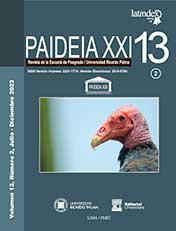URBAN TREES IN THE HABITABILITY OF NEIGHBORHOOD PUBLIC SPACES: A SUSTAINABLE VISION
DOI:
https://doi.org/10.31381/paideia.v10i1.2975Abstract
The need to increase and improve urban green has become a strategy for sustainable urban development; and in Peru there are no specific studies, nor adequate plans and projects that comprehensively contemplate the full potential of tree species in the urban space. Therefore, the objective was to propose a guide for the design of travel and stay spaces for Arróspide Park, located in Ate, a district of the metropolitan city of Lima, Peru and based on the physiological, ergonomic and psychological contributions of existing urban trees to benefit their habitability in a neighborhood public space. With a biocentric perspective, the morphological characteristics of the tree species were identified, the climatic conditions related to the thermal comfort of the people were measured and the physical restrictions of the park were analyzed. Finally, the results were contrasted with the theoretical framework based on the evaluation of public spaces and green spaces according to the Urban Ecology Agency of Barcelona, the principles of tree selection proposed by Trees & Design Action Group and the water-sensitive approach in the Green space design. After a comparison of tree species, 5 tree species: Tipa, Molle costeño, Jacaranda, Molle serrano and Melia were identified that, due to their morphological characteristics, provide comfort, demand a little water consumption, control the low urban proportion of the park, provide shade in park routes and stays, and offer a colored landscape throughout the year; generating conditions for the improvement of the habitability of public space.
Keywords: urban trees – neighborhood space – public space – habitability












